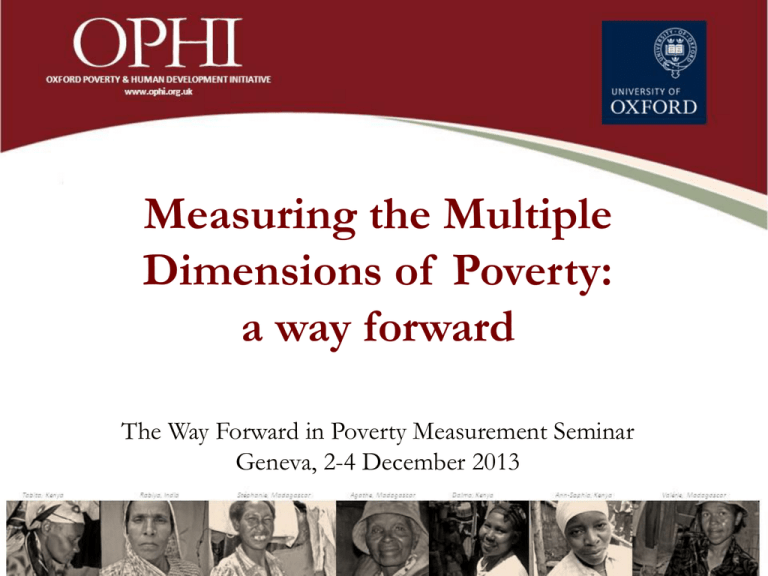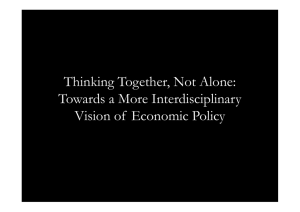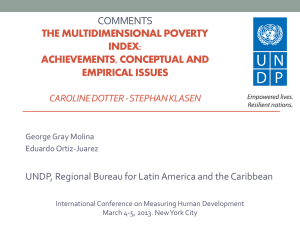OPHI – MPI Team - United Nations Economic Commission for Europe
advertisement

Measuring the Multiple Dimensions of Poverty: a way forward The Way Forward in Poverty Measurement Seminar Geneva, 2-4 December 2013 OPHI – MPI Team OPHI Research Team: Sabina Alkire (Director), James Foster (Research Fellow), John Hammock (Co-Founder and Research Associate), José Manuel Roche (coordination MPI 2011), Adriana Conconi (coordination MPI 2013), Maria Emma Santos (coordination MPI 2010), Suman Seth, Paola Ballon, Gaston Yalonetzky, Diego Zavaleta, Mauricio Apablaza Data analysts and MPI calculation 2013: Akmal Abdurazakov, Cecilia Calderon, Iván Gonzalez De Alba, Usha Kanagaratnam, Gisela Robles Aguilar, Juan Pablo Ocampo Sheen, Christian Oldiges and Ana Vaz. Special contributions: Heidi Fletcher (preparation of the maps), Esther Kwan and Garima Sahai (research assistance and preparation of graphs), Christian Oldiges (research assistance for regional decomposition and standard error), John Hammock (new Ground Reality Check field material), Yadira Diaz (helping in map preparation). Communication Team: Paddy Coulter (Director of Communications), Emmy Feena (Research Communications Officer), Heidi Fletcher (Web Manager), Moizza B Sarwar (Research Communications Assistant), Cameron Thibos (Design Assistant), Joanne Tomkinson. Administrative Support: Laura O'Mahony (Project Coordinator) OPHI prepare the MPI for publication in the UNDP Human Development Report and we are grateful to our colleagues in HDRO for their support. Outline • Motivations to consider a multidimensional approach for measuring poverty • The Alkire Foster (AF) methodology Global Multidimensional Poverty Index (MPI) • Properties of the AF method Illustrations • MPI 2015+ and the post-2015 development agenda Why Multidimensional Poverty Measures? Poor people’s lives can be battered by multiple deprivations that are each of independent importance. (Amartya Sen, 1992) Motivations for moving towards multidimensional poverty measure What we have: • Increasing data • Improving methodologies Technical What we need: Policy • Income poverty is important but insufficient • Growth has not been inclusive • Go beyond dazzlingly complex dashboards of indicators • Emphasising the joint distribution across deprivations Path ahead: Ethical and Political • Political critique of current metrics • Measures in 2010 HDR sparked interest and debate • MPI 2015+ for the post-2015 MDGs Increasing Data Income Poverty is Important, but not Sufficient (Global Monitoring Report Progress Status, 2013) 144 Number of Countries 128 112 96 80 64 48 32 16 0 Extreme Poverty Improved Water Target Met Moderately Off Target Primary Completion Undernourishment Sufficient Progress Seriously Off Target Sanitation Infant Mortality Insufficient Progress Insufficient Data Reduction in income poverty does NOT reduce other MDG deprivations automatically. Source of data: World Bank Data; computed by Suman Seth Economic Growth is Important, but Not Always Inclusive Indicators Gross National Income per Capita (in International $) Under-5 Mortality DPT Immunization Rate Adult Pop. with no Education Access to Improved Sanitation (rural pop) Year India Bangladesh 1990 2011 Growth (p.a.) 1990 2011 Change 1990 2010 Change 1990 2010 Change 1990 2010 Change 860 3620 6.8% 114.2 61.3 -52.9 70 72 2 51.6 32.7 -18.9 7 23 16 550 1940 5.9% 138.8 46.0 -92.8 69 95 26 55.5 31.9 -23.6 34 55 21 Nepal 510 1260 4.2% 134.6 48.0 -86.6 43 82 39 65.8 37.2 -28.6 7 27 20 Source: Alkire and Seth (2013). The table is inspired by Drèze and Sen (2011), with minor additions. Going Beyond Dazzlingly Dashboards of Indicators Proportion of population below $1 (PPP)/day Share of women in wage employment in the nonagricultural sector Net enrolment ratio in primary education Prevalence of underweight children under 5 years of age Literacy rate of 15-24 years-old Prevalence of deaths associated with malaria Proportion of tuberculosis cases detected and cured under DOTS Maternal mortality ratio Proportion of seats held by women in national parliament Identifying Joint Distribution of Deprivations deprived=1; non-deprived=0 Case 1 Abby Jane Jon Tania Illiterate Undernourished No safe water Low income 1 0 0 0 0 1 0 0 0 0 1 0 0 0 0 1 Illiterate Undernourished No safe water Low income 0 0 0 1 0 0 0 1 0 0 0 1 0 0 0 1 Case 2 Abby Jane Jon Tania In both cases, 25% deprived in each MDG indicator BUT, in Case 2, one person is severely deprived Political recognition • “MDGs did not focus enough on reaching the very poorest” High-Level Panel on the Post-2015 Development Agenda (2013) Should be able to distinguish poorest from the less poor • “Acceleration in one goal often speeds up progress in others; to meet MDGs strategically we need to see them together” What Will It Take to Achieve the Millennium Development Goals? (2010) Emphasis on joint distribution and synergies • “While assessing quality-of-life requires a plurality of indicators, there are strong demands to develop a single summary measure” - Stiglitz Sen Fitoussi Commission Report (2009) One summary index is more powerful in drawing policy attention Value-added of a Multidimensional Approach What can a meaningful multidimensional measure do? • • • • • • Provide an overview of multiple indicators at-a-glance Show progress quickly and directly (Monitoring/Evaluation) Inform planning and policy design Target poor people and communities Reflect people’s own understandings (Flexible) High Resolution – zoom in for details by regions, groups, or dimensions The Global Multidimensional Poverty Index (MPI) - applying Alkire Foster (AF) method AF Method: An Overview • Identification of poor – Dual cutoffs Deprivation cutoffs - each deprivation counts Poverty cutoff - in terms of aggregate deprivation values • Aggregation across the poor – Adjusted FGT • Adjusted Headcount Ratio (Mο): Formula: Mο = H × A H: The percent of people identified as poor, the incidence of multidimensional poverty A: The average proportion of deprivations people suffer at the same time; intensity of people’s poverty Source: Alkire & Foster, 2011, J. of Public Economics Application of the AF Method: Global MPI 1. 2. 3. 4. 5. Select dimensions Select indicators, unit of analysis & weights (Flexible) Set deprivation cutoffs for each indicator (Flexible) Set a poverty cutoff, (k) to identify who is poor (Flexible) Calculate Adjusted Headcount Ratio (M0) – Reflects incidence (H), intensity (A) Note: The AF methodology does not specify dimensions, indicators, weights, or cutoffs; it is flexible and can be adapted to many contexts. (Source: Alkire, S & Santos, M.E., 2010) One implementation of the AF Method Global MPI (1/6) (1/6) (1/6) Education (1/3) Deprived if no household member has completed five years of schooling Health (1/3) Asset Ownership (1/6) Floor Nutrition Electricity Child Mortality Water School Attendance Sanitation Years of Schooling Cooking Fuel 10 Indicators (1/18 Each) Standard of Living (1/3) 3 Dimensions Dimensions are equally weighted, and each indicator within a dimension is equally weighted Identify Who is Poor A person is multidimensionally poor if she is deprived in 1/3 of the weighted indicators. (censor the deprivations of the non-poor) 39% 33.3% Properties of the AF method -An illustration using findings from MPI 2013 Properties of AF method: an overview • Can be broken down into incidence (H) and the intensity (A) • Is decomposable across population subgroups – Overall poverty is population-share weighted average of subgroup poverty • Overall poverty can be broken down by dimensions & indicators to understand their contribution 20 Incidence (H) vs. Intensity (A) Country A: Country B: Poverty reduction policy (without inequaliy focus) Multidimensional Headcount (H) 75.00 70.00 Intensity Intensity of Deprivations (A) Multidimensional Multidimensional Headcount Headcount (H) (H) Multidimensional Poverty Index (MPI = H * A) 60.00 0.42 59.00 0.41 58.00 Policy oriented to the poorest of the poor 0.40 75.00 75.00 Before 70.00 70.00 Intensity of Intensityof Deprivations Deprivations (A) (A) 60.00 60.00 0.42 0.42 59.00 59.00 0.41 0.41 58.00 58.00 57.00 57.00 0.38 60.00 56.00 0.36 54.00 0.35 53.00 55.00 65.00 65.00 0.37 55.00 After 60.00 60.00 0.34 0.33 52.00 56.00 56.00 50.00 50.00 55.00 55.00 0.37 0.37 0.36 0.36 54.00 54.00 0.35 0.35 53.00 53.00 0.34 0.34 0.33 0.33 52.00 52.00 0.32 0.32 51.00 51.00 0.31 0.30 Before Before 0.38 0.38 55.00 55.00 0.32 51.00 0.40 0.40 0.39 0.39 0.39 57.00 65.00 Multidimensional Multidimensional Poverty Poverty Index Index (MPI (MPI = =H H ** A) A) 50.00 50.00 50.00 50.00 0.31 0.31 0.30 0.30 Country B reduced the intensity of deprivation Roche (2013) among the poor more. The Source: final index reflects this. After Uneven Reduction in MPI across Population Subgroups: India (1999-2006) Muslim () [0.32] Hindu (*) [0.306] Christian () [0.196] Religion Sikh (*) [0.115] ST (*) [0.458] SC (*) [0.378] OBC (*) [0.301] Caste General (*) [0.229] Rural (*) [0.368] Urban (*) [0.116] -0.110 22 -0.090 -0.070 -0.050 -0.030 Absolute Change (99-06) in MPI-I -0.010 Source: Alkire and Seth (2013) States (Significance) [MPI-I in 1999] Slower progress for Scheduled Tribes (ST) and Muslims Dimensional Breakdown Nationally Absolute Change in CH Ratio India (1999-2006) 23 0.0% -2.0% -4.0% -6.0% -8.0% -10.0% -12.0% Indicator (Statistical Significance) [1999 CH Ratio] Source: Alkire and Seth (2013) Dimensional Breakdown in Six States India (1999-2006) 24 Source: Alkire and Seth (2013) Distribution of Intensities among the Poor Madagascar (2009) MPI = 0.357 H = 67% Rwanda (2010) MPI = 0.350 H = 69% Source: Alkire , Roche &Seth (2013) The Global MPI 2015+ In the Post 2015 MDG Development Agenda Moving towards a MPI 2015+ Findings from Global MPI: - $1.25/poverty and MPI do not move together - MPI reduction is often faster than $1.25/day poverty - Political incentives from MPI are more direct Niger Ethiopia Mali Burundi Burkina Faso Liberia Guinea Somalia Mozambique Sierra Leone Senegal DR Congo Benin Uganda Rwanda Timor-Leste Madagascar Malawi Tanzania Zambia Chad Mauritania Cote d'Ivoire Gambia Bangladesh Haiti Togo Nigeria India Cameroon Yemen Pakistan Kenya Lao Cambodia Nepal Republic of Congo Namibia Zimbabwe Lesotho Sao Tome and Principe Honduras Ghana Vanuatu Djibouti Nicaragua Bhutan Guatemala Indonesia Bolivia Swaziland Tajikistan Mongolia Peru Iraq Philippines South Africa Paraguay China Morocco Suriname Guyana Estonia Turkey Egypt Trinidad and Tobago Belize Syrian Arab Republic Colombia Sri Lanka Azerbaijan Maldives Kyrgyzstan Dominican Republic Hungary Croatia Viet Nam Mexico Czech Republic Argentina Tunisia Brazil Jordan Uzbekistan Ecuador Ukraine Macedonia Moldova Uruguay Thailand Latvia Montenegro Palestinian Territories Albania Russian Federation Serbia Bosnia and Herzegovina Georgia Kazakhstan United Arab Emirates Armenia Belarus Slovenia Slovakia Comparing the Headcount Ratios of MPI Poor and $1.25/day Poor 100% 90% 80% 70% 60% 50% Height of the bar: MPI Headcount Ratio Height at ‘•’ : $1.25-a-day Headcount Ratio 40% 30% 20% 10% 0% Intensity 69.4% & More Intensity 50-69.4% Intensity 44.4-50% Intensity 33.3-44.4% $1.25 a day Source: Alkire , Roche &Seth (2013) MPI 2015+ for the Post-2015 MDGs (Alkire and Sumner 2013) - To complement $1.25/day poverty - To reflect interconnections between deprivations: how people are poor - Emphasis on participatory discussions & expert views - National MPI should be recognised and reported internationally The Global Multidimensionl Poverty Peer Network (MPPN) Angola, Bhutan, Brazil, Chile, China, Colombia, Dominican Republic, ECLAC, Ecuador, El Salvador, Germany, India, Iraq, Malaysia, Mexico, Morocco, Mozambique, Nigeria, OECD, the Organization of Caribbean States, OPHI, Peru, Philippines, SADC, Tunisia, Uruguay and Vietnam Launch of Global MPPN, June 2013 • Founded by OPHI with Mexico’s CONEVAL and Colombia’s DNP & financial support from BMZ • Launched by President Santos of Colombia • Roundtable discussion on the MPPN by Ministers • Amartya Sen Lecture on “Discovering Women” The MPPN Moving Forward • Expansion of Multidimensional Poverty Index Official national poverty measures Subnational Pilots (China, Brazil) • An Effective and Informed Voice in the Post 2015 Discussions Colombia, Mexico, Germany, OPHI and the MPPN host a side event at the UN General Assembly 2013 • The Promotion of Joint Research and Development of Practical Tools Summary • Emphasizes on joint distribution of deprivations • Decompositions by subpopulation - policy relevance • Flexible and can be adapted to national contexts • MPI 2015+: comparable across countries • National MPI and Global MPI 2015+ can be reported like national income poverty and $1.25/day References: Alkire, S. and Santos, M.E. 2010. Acute multidimensional poverty: a new index for developing countries. OPHI Working Paper 38, Oxford Poverty and Human Development Initiative, University of Oxford. Alkire, S. and Foster, J.E. 2011. Counting and multidimensional poverty measurement. Journal of Public Economics, 95 (7-8): 476-487. Alkire, S. and Sumner, A. 2013. Multidimensional Poverty and the Post-2015 MDGs. OPHI Briefing Note. http://www.ophi.org.uk/wp-content/uploads/MPI-post-2015-MDGs-FINAL.pdf?cda6c1 Alkire, S. and Seth, S. 2013. “Multidimensional Poverty Reduction in India 1999 and 2006: Slowest Progress for the Poorest Groups”, Research Brief, Oxford Poverty & Human Development Initiative, Oxford University. http://www.ophi.org.uk/wp-content/uploads/Multidimensional-Poverty-Reduction-in-India-199920061.pdf?3f40f1 Alkire, S. and Roche, J.M. 2013. ‘Multidimensional Poverty Index 2013’, Research Brief, Oxford Poverty & Human Development Initiative, Oxford University. http://www.ophi.org.uk/wp-content/uploads/Multidimensional-Poverty-Index-2013-Alkire-Roche-and-Seth.pdf Drèze J and Sen, A.K. 2011. “Putting Growth In Its Place”, Outlookindia.com Magazine, November 2011, accessed at www.outlookindia.com/article.aspx?278843 on January 11, 2013. Weblinks: High-Level Panel on the Post-2015 Development Agenda (2013) http://www.post2015hlp.org/the-report/ Stiglitz Sen Fitoussi Commission Report (2009) http://stiglitz-sen-fitoussi.fr/documents/rapport_anglais.pdf What Will It Take to Achieve the Millennium Development Goals? (2010) http://www.undp.org/content/undp/en/home/librarypage/mdg/international-assessment---english-fullversion.html Thank You More information: The Global MPI is published annually in the Human Development Report of UNDP Working Papers and resources available on www.ophi.org.uk





